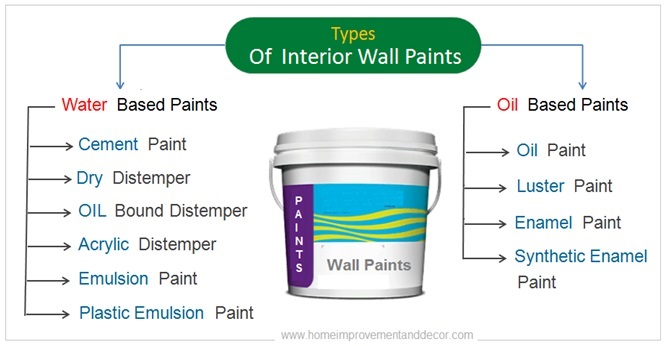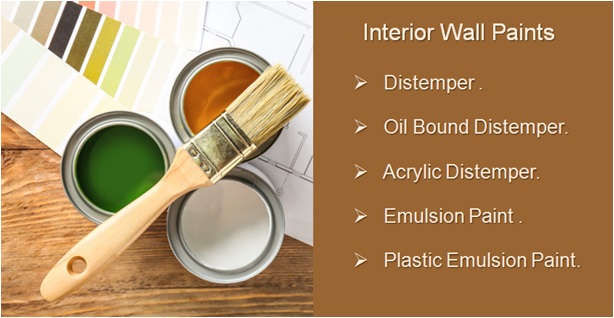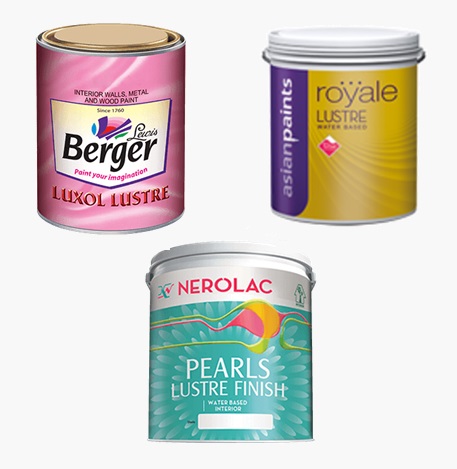
Types Of Interior Wall Paints
Wall PaintTypes
If you are planning to upgrade the look of your house then the selecting of correct type of the wall paint is an important decision.
As you enter any home improvement store , you will find many different types of interior wall paints. The wall paint companies offer extensive range of interior paints each type of paint offer different features.
It is important for any successful interior wall painting DIY project to select the correct type of wall paint that fits into your requirements and budget.
The chemical composition of different types of paint is different. And therefore, each paint is suitable for a particular type of application.

In this article, we will discuss different types of interior wall paints available in the market , technical features, advantages and other important selection criterion for interior wall paint types.
Types Of Interior Wall Paints
Table Of Contents
- Types Of Interior Wall Paints.
- Water Based Interior Paints.
- Oil Based Interior Paints.
- Cement Paints.
- Dry Distemper Paints.
- OBD Distemper Paints.
- Acrylic Distemper Paints.
- Emulsion Paints.
- Plastic Emulsion Paints.
- Luster Paint.
- Oil Paint.
- Enamel Paint.
Types Of Interior Wall Paints
The interior wall paints can be grouped into two basic types. The first type of interior wall paint is water based and the second type is oil based.
The water based type of interior paints include cement paints, dry distemper , oil bound distemper ( OBD ) , acrylic distempers , emulsion paints and plastic emulsion paints.
The oil based interior paints use oil as vehicle. The oil based interior paints include oil paint, lustre paints and the enamel paints.
You will also notice another type of paints called two-in-one paint available in the market. This is a duel purpose paint and basically a combination of two types of paints ( wall paint + Primer ). These paints do not require prior application of the primer coat.
The interior wall paints can be grouped into two basic types :
- Water Based Interior Paints.
- Oil Based Interior Paints.
Paint Type | Category | Coverage | Price |
Distemper | Water Based | Low | Inexpensive |
OBD Distemper | Water Based | Low | Inexpensive |
Acrylic Distemper | Water Based | Moderate | Inexpensive |
Cement Paint | Water Based | Low | Inexpensive |
Emulsion | Water Based | Good | Expensive |
Plastic Emulsion | Water Based | Good | Expensive |
Lustre | Oil Based | Good | Expensive |
Water Based Interior Wall Paints
The water based paints are commonly referred to as emulsion paints or latex paints. The water based interior wall paints are water soluble.
The water based paints are the most commonly used interior wall paints available in the market.
In these paints the water can be added in the required proportion either for making the paint or as paint thinner to dilute the paint.

Oil Based Interior Wall Paints
The oil based paints are commonly referred to as enamel paints. The oil based interior wall paints are made up of oil as a base and can be diluted with oil thinners.
The oil based paints render long lasting and durable surface with excellent finish. The user has option to buy either ready made shade or to create a desired shade using paint stainer.
In these paints the recommended paint thinner such as turpentine can be added in the required proportion to dilute the paint.
Each paint brand has many products in the same category. And therefore, the user must refer to the usage instructions mentioned on the paint can.
Lime Whitewash
This is the most economical paint among all the paints. As the name suggest the lime whitewash is prepared from the lime ( Slaked Lime ). It is a water based paint.
The lime is available in the market either in the powder form or in lumps. Due care should be taken while adding the water into the life as it generates considerable heat.
It is a common practice to add the color stainner or any colour pigment to create the desired shade. And such coloured lime paint is referred as colour wash.

The paint can be used once the initial chemical reaction and heat generation is over usually after an hour after adding the water.
The lime whitewash does not have good binding property. And hence, any water soluble binding agent ( Such as Fevicol ) is added at the time of preparation to enhance the binding property of the lime whitewash.
Advantages Of Lime Whitewash
- Easy To Apply.
- Most Economical.
- Easy To Maintain.
- High Coverage.
Features Of Lime Whitewash
- Water Used As Thinner.
- Binding Agent Required.
- Color Stainer Required.
- High Coverage.
Dry Distemper
The dry distemper is an improved version of the lime whitewash and renders more durable paint surface. The dry distemper is sold in the market in the powder form at very reasonable price.
The dry distemper is also readily available in many shades. Further , it also contains binging agent and therefore the distemper paint binds quite good with the wall surface.
The dry distemper is prepared by adding water to the distemper powder in the required quantity as mentioned in the product description.

Advantages Of Dry Distemper
- Easy To Apply.
- Most Economical.
- Easy To Maintain.
- Low Coverage.
Features Of Dry Distemper
- Water Based Paint.
- Need To Add Binder.
- Color Shades Available.
- Color May Fade.
Cement Paint
The cement paint is similar to the dry distemper in many ways except that the base material has offers cementing properties .
The cement paints are also readily available in many shades. Due to its cement content the paint binds quite good with the wall surface.
The cement paints are mainly used for exterior painting but it can also be used on interior walls especially when the wall may have some dampness.
The cement paint needs to be cured for few days similar to any other cement based products to achieve its full strength. However , some companies have launched cement paint that does not need curing.

Advantages Of Cement Paint
- Easy To Apply.
- Quite Economical.
- Easy To Maintain.
- Good Coverage.
Features Of Cement Paint
- Curing Is Required.
- Suitable For Damp Walls.
- Color Shades Available.
- Water Based Paint.
Oil Bound Distemper ( OBD ) Paint
The oil bound distemper ( OBD ) is a improved version of dry distemper. The oil bound distemper is sold in the market by many reputed brands in the semi liquid paste packed in a container.
The OBD is water soluble paint despite being a oil based paint. The OBD contains some special polymers that renders a durable paint surface that is washable with mild soap solution.
The OBD is prepared by adding the water into the paint mixture as specified in the product description.
Advantages Of Oil Bound Distemper
- Easy To Apply.
- Value For Money.
- Easy To Maintain.
- High Coverage.
- Washable.
Features Of Oil Bound Distemper
- Stain Resistance.
- Water Based Paint.
- Vast Color Shades.
- Water Based Paint.
- Binder Not Required.
Acrylic Distemper Paint
The acrylic distemper is a premium quality oil bound distemper that comes in the category of luxury emulsion paints.
The acrylic distemper is a premium product that renders a long lasting durable paint surface . This paint offers a better resistance to the stains and it can be easily be washed with mild soap solution.
The acrylic distemper is water soluble paint despite being a oil based paint. This paint is available in the market manufactured by many leading brands .

The acrylic distemper is prepared by adding the water as a thinner into the acrylic distemper mixture in the required proportion as mentioned in the product description.
The acrylic distemper paint cannot be directly applied on the wall surface. The wall surface must be first prepared by applying cement primer and two to three layers of putty.
The acrylic emulsion paint is available in both glossy and matte finish.
Advantages Of Acrylic Distemper
- Easy To Apply.
- Stain Resistant.
- Easy To Maintain.
- High Coverage.
- Washable Surface.
Features Of Acrylic Distemper
- Water Based Paint.
- Ready To Use Paint.
- Vast Color Shades.
- Not Suitable For Damp Walls.
- Quick Drying Paint.
Emulsion Paint
The emulsion paint is a type of interior wall paint extensively used to paint the interior wall surfaces. Most leading paint brands have range of emulsion paints easily available in any home improvement store.
The emulsion paints essentially consist of a medium , acrylic resin , pigments and other additives. The acrylic resin renders the surface binding property to the paint and the pigment provides the desired color shade.
The emulsion paint is a water based and water soluble paint that can diluted with water ( used as paint thinner ) to get the required consistency.

The ease of use ,wide verity of attractive colors, long life and the reasonable price makes this paint a preferred choice for the most people.
The emulsion paints can be easily applied on the wall surface either by brush or by roller brush or by spray gun.
The emulsion paints are available in both glossy and matte finish.
Plastic Emulsion Paint
The plastic emulsion paint is another most popular term used in the interior wall paint work.
The plastic emulsion is top of the line a premium quality paint that comes in the category of luxury emulsion paints.
As the name suggest the plastic paint contains some special polymers that renders some additional properties of the plastic to the painted surface.
The plastic emulsion paint creates an elegant visual effect with its flawless finish and super smooth surface.
The plastic emulsion paint is a water soluble paint that renders a rich luxury look to the wall surface. The paint surface can easily be cleaned with mild soap solution and it retains the original color shade .


The latest range of luxury plastic emulsion paints provides a protection of Teflon coated surface that is highly resistant to all types of wear and tear.
The latest range of luxury plastic emulsion paints also offer antifungal and antibacterial properties. These paints also minimize the problem of mold fungus that causes black spots on the wall surface in damp condition.
The plastic emulsion paint can be applied only on the prepared surface . The surface is prepared by applying cement primer followed by two to three coats of putty.
The plastic emulsion paint is available in both glossy matte and other popular interior wall paint finishes.
Advantages Of Plastic Emulsion Paint
- Drop Dead Gorgeous.
- Stain Resistant.
- Easy To Maintain.
- High Coverage.
- Washable Surface.
- Anti Fungal,
- Teflon Coated Surface.
Features Of Plastic Emulsion Paint
- Water Based Paint.
- Ready To Use Paint.
- Vast Color Shades.
- Anti-Fungal.
- Anti Bacterial.
- Not Suitable For Damp Walls.
- Quick Drying Paint.
Luster Paint
The lustre paint is one of the most commonly used paint extensively used for the interior walls. It comes in the category of enamel paint that is oil based paints.
Some companies have also launched water based lustre paint but the oil based lustre paint is the most popular choice for the interior walls.
The lustre paint is generally sold in the market in white shade. The suitable shade is prepared by adding the stainer into the whine lustre paint mixture.
The lustre paint is available in the market in both glossy and matte finish.
The lustre paint should be used only on the completely dry wall. The presence of any seepage may cause serious flaking and peeling problems.


Advantages Of Luster Paint
- Good Finish.
- Stain Resistant.
- Easy To Maintain.
- Good Coverage.
- Washable Surface.
- Anti Fungal.
- Texture Can Be Added.
Features Of Luster Paint
- Oil Based Paint.
- Needs Color Stainer.
- Vast Color Shades.
- Anti Bacterial.
- Not Suitable For Damp Walls.
- Long Drying Paint.
- Fumes After Application.

